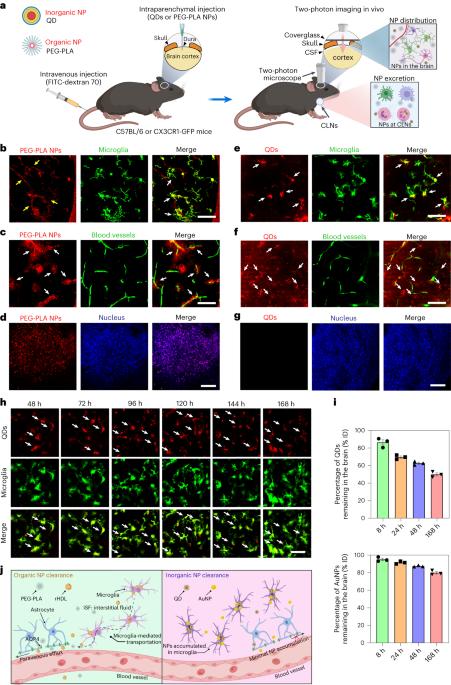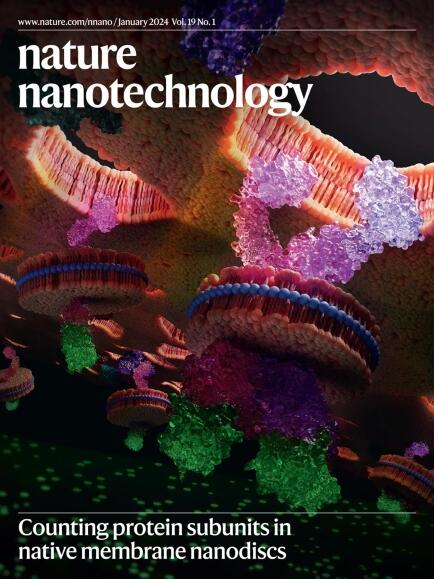Intracerebral fate of organic and inorganic nanoparticles is dependent on microglial extracellular vesicle function
IF 34.9
1区 材料科学
Q1 MATERIALS SCIENCE, MULTIDISCIPLINARY
引用次数: 0
Abstract
Nanoparticles (NPs) represent an important advance for delivering diagnostic and therapeutic agents across the blood–brain barrier. However, NP clearance is critical for safety and therapeutic applicability. Here we report on a study of the clearance of model organic and inorganic NPs from the brain. We find that microglial extracellular vesicles (EVs) play a crucial role in the clearance of inorganic and organic NPs from the brain. Inorganic NPs, unlike organic NPs, perturb the biogenesis of microglial EVs through the inhibition of ERK1/2 signalling. This increases the accumulation of inorganic NPs in microglia, hindering their elimination via the paravascular route. We also demonstrate that stimulating the release of microglial EVs by an ERK1/2 activator increased the paravascular glymphatic pathway-mediated brain clearance of inorganic NPs. These findings highlight the modulatory role of microglial EVs on the distinct patterns of the clearance of organic and inorganic NPs from the brain and provide a strategy for modulating the intracerebral fate of NPs. Nanoparticle clearance is critical for safety and therapeutic applicability. Here the authors report the modulatory role of microglial extracellular vesicles on the brain clearance of organic and inorganic nanoparticles and provide a strategy to control their intracerebral fate.


有机和无机纳米粒子的脑内归宿取决于小胶质细胞外囊泡的功能
纳米粒子(NPs)是通过血脑屏障递送诊断和治疗药物的一项重要进展。然而,NP 的清除对于安全性和治疗适用性至关重要。在此,我们报告了一项关于模型有机和无机 NPs 在大脑中清除情况的研究。我们发现,小胶质细胞外囊泡 (EV) 在清除脑内无机和有机 NPs 的过程中起着至关重要的作用。与有机 NPs 不同,无机 NPs 会通过抑制 ERK1/2 信号干扰小胶质细胞胞外小泡的生物生成。这增加了无机 NPs 在小胶质细胞中的积累,阻碍了它们通过血管旁途径被清除。我们还证明,通过ERK1/2激活剂刺激小胶质细胞EVs的释放,可增加血管旁淋巴途径介导的大脑对无机NPs的清除。这些发现强调了小胶质细胞 EVs 对大脑清除有机和无机 NPs 的不同模式的调节作用,并为调节 NPs 的脑内命运提供了一种策略。
本文章由计算机程序翻译,如有差异,请以英文原文为准。
求助全文
约1分钟内获得全文
求助全文
来源期刊

Nature nanotechnology
工程技术-材料科学:综合
CiteScore
59.70
自引率
0.80%
发文量
196
审稿时长
4-8 weeks
期刊介绍:
Nature Nanotechnology is a prestigious journal that publishes high-quality papers in various areas of nanoscience and nanotechnology. The journal focuses on the design, characterization, and production of structures, devices, and systems that manipulate and control materials at atomic, molecular, and macromolecular scales. It encompasses both bottom-up and top-down approaches, as well as their combinations.
Furthermore, Nature Nanotechnology fosters the exchange of ideas among researchers from diverse disciplines such as chemistry, physics, material science, biomedical research, engineering, and more. It promotes collaboration at the forefront of this multidisciplinary field. The journal covers a wide range of topics, from fundamental research in physics, chemistry, and biology, including computational work and simulations, to the development of innovative devices and technologies for various industrial sectors such as information technology, medicine, manufacturing, high-performance materials, energy, and environmental technologies. It includes coverage of organic, inorganic, and hybrid materials.
 求助内容:
求助内容: 应助结果提醒方式:
应助结果提醒方式:


